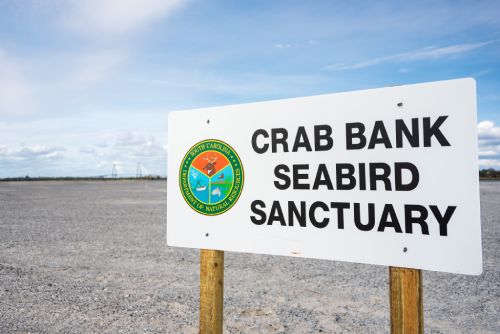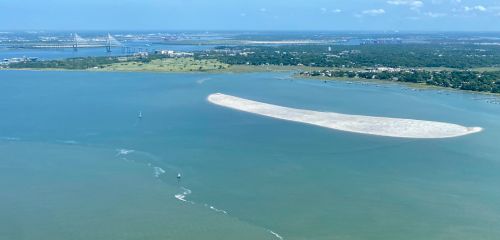SCDNR News
Successful shorebird nesting season on a newly restored Crab Bank
CHARLESTON COUNTY
October 11, 2022

South Carolina Department of Natural Resources (SCDNR) biologists are celebrating the close of a successful shorebird and seabird nesting season on the newly restored Crab Bank Seabird Sanctuary. Biologists documented over 500 nests over the season, marking the first time coastal birds nested on the small island in Charleston Harbor since its disappearance to erosion. Watch a short video of 2022 nesting highlights here.
"This year was a unique opportunity to study how birds respond to newly available habitat after a four-year absence. The last year birds attempted nesting on Crab Bank, before it completely eroded, was in 2017," said SCDNR biologist Janet Thibault.
Shorebirds and seabirds are declining worldwide, and the 2017 loss of the crucial nesting site in Charleston Harbor – one of just a handful in South Carolina – inspired a pioneering solution: In late 2021, the island was rebuilt with material dredged from the deepening of Charleston Harbor through a partnership with the Army Corps of Engineers, a project that garnered widespread support from community members, conservation groups and elected officials.
Hopes were high that South Carolina’s shorebirds and seabirds would quickly find and make use of the new habitat – and the birds did not disappoint. Biologists discovered the first nest of the 2022 season, belonging to a pair of American oystercatchers, on April 1. Eight pairs of oystercatchers eventually nested on the island over the season, including a four-year-old bird that was originally banded as a chick on Cumberland Island, Georgia.
Least terns, small, State Threatened seabirds, colonized the island in late April. Over 100 pairs nested on the island, and their fledglings gathered along the waterline in late May and June.
"Least terns are quick to find suitable habitat," said SCDNR biologist Mary Catherine Martin. "These birds suffered nesting loss at other sites this spring because of extreme high tides, but Crab Bank was the perfect site for a successful season."
In the second week of May, a strong storm put Crab Bank to the test during during the heart of nesting season. A two-day storm blew through Charleston with 35-knot winds, driving typically five-foot high tides over seven feet above sea level for several tidal cycles. The island suffered some escarpment on its southern waterline, but it experienced no seawater inundation.
One of the most spectacular sights this nesting season was the return of black skimmers and gull-billed terns to the island. Skimmers feed in flight by opening their orange and black bill and dipping the narrow lower mandible in the water to feel for fish to eat. Gull-billed terns have heavy bills, which they use to grab fiddler crabs off the beach, and give a remarkable call, almost a giggle, while in flight. SCDNR biologists counted 237 skimmer nests and 179 gull-billed tern nests in May.
Hatching success for both species was high, with parents attending to chicks throughout the summer. For these species that rely on beach habitat with little to no vegetation to lay their eggs, Crab Bank provided ideal habitat. Black skimmers and gull-billed terns were able to nest in the interior of the island, safe from the lapping waves and inundating tides that often wash over their favored barrier island beaches.
SCDNR Marine Resource Division staff have been monitoring Crab Bank since its completion in November 2021, using drones to collect high-resolution imagery and elevations of the island. The island comprises approximately 35 acres ranging between 5 and 8 feet above the high tide waterline. A grant from the National Fish & Wildlife Foundation obtained by Audubon South Carolina paid for the mapping work.
"With our imagery, we were able to determine how much habitat was created for nesting birds. Having accurate elevation data allows us to know how this area will fare under different tide conditions" said SCDNR biologist Gary Sundin. A member of the agency’s Shellfish Research Section, Sundin’s team regularly uses drone imagery to map oyster beds. "The amount of available habitat in September 2022 is the same as it was in December of 2021, so very little change has occurred to the available habitat above the high tide line."

Following Hurricane Ian, which made landfall in South Carolina as a Category 1 hurricane, staff reported that the island received no saltwater inundation and remained, as designed, well above the storm’s tidal level.
Kayakers and boaters heading in and out of Shem Creek have been able to see seabirds once again resting along the waterline and soaring over the harbor. With grant money from the National Fish & Wildlife Foundation that Audubon South Carolina obtained, Coastal Expeditions, an ecotour company, took over 4,000 students and members of the public to see the wildlife on Crab Bank from the water.
"We've been able to bring school children that would not otherwise be able to afford a field trip to see the amazing restoration and learn about coastal birds and how to steward them," said Karen Monahan of the Coastal Expeditions Foundation.
SCDNR is deeply grateful to the community and the suite of conservation organizations that helped make this project possible with fundraising support – particularly the Coastal Conservation League, Coastal Expeditions and Audubon South Carolina. The Coastal Bird Conservation Fund was created to collect funds for the restoration of Crab Bank and is now being used for additional conservation projects. To learn more about the Coastal Bird Conservation program and how you can help support coastal bird habitats in SC, visit the SCCBC website.
SCDNR-owned Crab Bank Seabird Sanctuary is completely closed from March 15 through October 15. From October 16 through March 14, public access on Crab Bank is allowed only in the intertidal zone. Dogs and camping are prohibited year-round.
For additional information, contact:
Erin Weeks at (843) 729-3531
WeeksE@dnr.sc.gov



